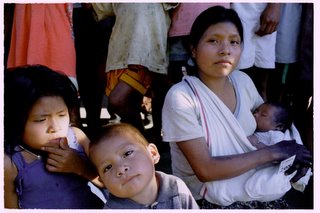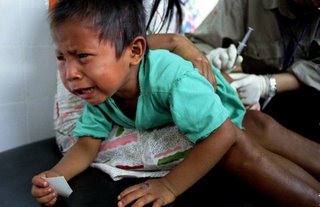

The Root starts work early, cooking breakfast around 6am, and punching in around seven. But so do the patients. The lines began to form before the doctors arrived at the clinic. Young mothers, some only 14 or 15, were the first to show up. Reserved, stoic, and extremely suspicious of outsiders, they spoke as little as possible. Their hands were often stained black from the crushed leaves of the Huito plant that is used to dye their hair. Most of them had a young child feeding off one of their breasts. For the women in their thirties, it wasn’t uncommon for them to already have 6 or 7 children. The men of the village showed up later in the day, and while more willing to talk than their wives do, they still remained extremely suspicious of the doctors. Their bodies are strong from the heavy labor and nighttime hunting expeditions that are a part of their survival. Scars and disfigured bones from injuries that never quite healed right add to their sometimes-somber features.
The older patients, some who were old enough to remember the time when the Aguaruna still practiced headhunting, were the hardest to treat. Their traditional Amazonian facial tattoos as striking as their omnipotent gaze. What little experience they may have had with outsiders was in most cases pretty unpleasant. After a lifetime of working the Amazon jungle, many went to the Root seeking relief from pains, something that doctors cannot cure. Others suffering from illnesses that Aguaruna medicine could not cure visited the clinic unaware that they were suffering from high blood pressure or diabetes brought on by an unbalanced diet, consisting mostly of sugars and carbohydrates. The long-term treatment needed to control these type of illness cannot be provided during the short medical service provided by the Root. The prescriptions given out are extremely useful, but can only last for a limited period of time. However something as simple as dietary and health education provided by a doctor can go a long way to improving the health of a patient.
Living in the harsh environment of the Amazon dealing with parasites is a way of life, and the majority of the patients treated by the Root suffered from some type of parasitic infection. Skin diseases like scabies are the most common, with intestinal bugs coming in a close second. Often, patients don’t even know they are sick until their stomachs or testicles shows signs of swelling. For this reason, the Root took random blood samples from arriving patients in order to get a better understanding of the level of parasitic infection in the community. Under the microscope of the Root parasite expert, Professor Cheung, bugs like Chagis disease and malaria were identified and treated. Others were not so lucky. On one of his scouting trips near the Equador border, Root President, Dr. Liu, came across a sick child in one of the more remote inland villages. As he was only there on a quest to find the next location for the Root doctors he had with him only the barest of supplies, and no medicine. His only companions were his translator Jim and the policeman Felipe. The child was brought to Dr. Liu by her parents who asked if there was anything he could do for her. While his training is in dentistry, Dr. Liu was still able to recognize that the child was suffering from malaria and pleaded with her parents to let him take the child down river to the Root camp for treatment. The parents, adamant in their superstitions, refused. They said they felt that their child would suffer even more if she were taken away from her home. Dr. Liu left a couple hours later. Shortly after, he got word from a contact in the area that the child had died.
No comments:
Post a Comment